What picture comes to your mind when you think about Mongolia? For many people, these are images of wide steppe and hills with grassland, sunny skies, horses and nomad tents scattered among the landscape. While these things can be found in many places in Mongolia, there is no area that matches these stereotypes as much as the central part of the country, west of Ulaanbaatar. And this is where my second trip took me after I had returned from the Gobi desert.
I had already had contact with a young guy from UB that works as a guide and driver, and when I met him he made me some suggestions of which places to visit. He was very knowledgeable about the area and had a lot of experience with tours through the whole country, so we fixed a rough schedule for a 10 day trip, and then all we had to do is to wait for the last member of our group, my friend Nina from Frankfurt who came to Mongolia for a 3 week vacation.
As in the previous trip, we decided to go as cheap as possible, which means sleeping in tents as much as possible and cooking for ourselves with a camping stove. Mongolia is simply the best country for camping I have ever seen. Outside of the city, the country is completely empty, which means that there are no facilities like camp sites, but loads of idyllic spots where you can just stop, put up your tent and enjoy the beautiful surroundings. On the first night we stopped at some sand dunes just a few hours out of UB. They reminded me a bit of Khorgoryn Els from the Gobi Trip, in fact this area is also called “Mini Gobi”.
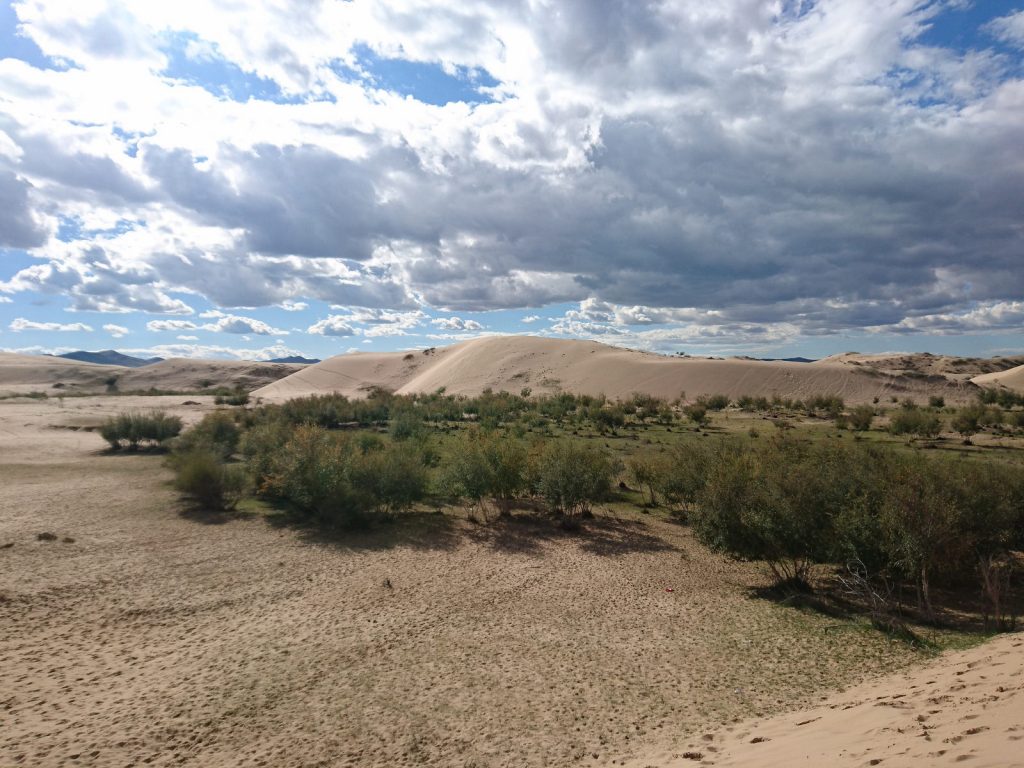
The next day we left the paved road and would go offroad again for several days. This time the offroad driving was a bit different than in the Gobi. Our driver Naraa had a small, but very robust car where you could feel every bump and every pothole on the street. The landscape was a lot more diverse than in the Gobi, with streams that had to be crossed and muddy sections where we almost got stuck.
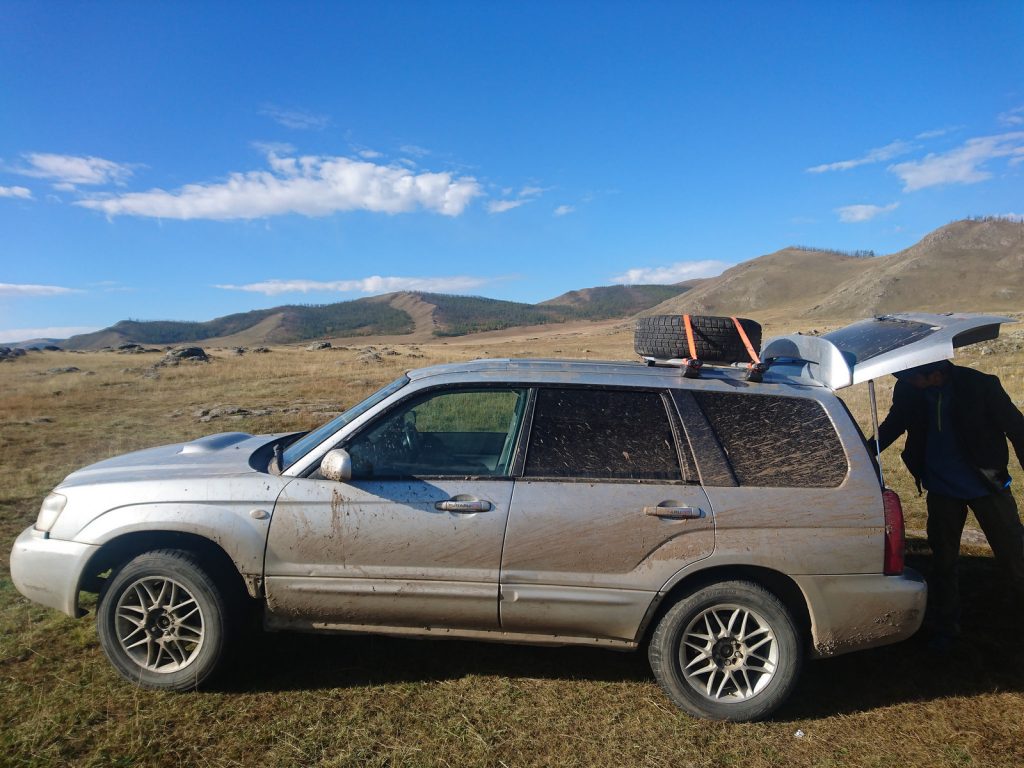
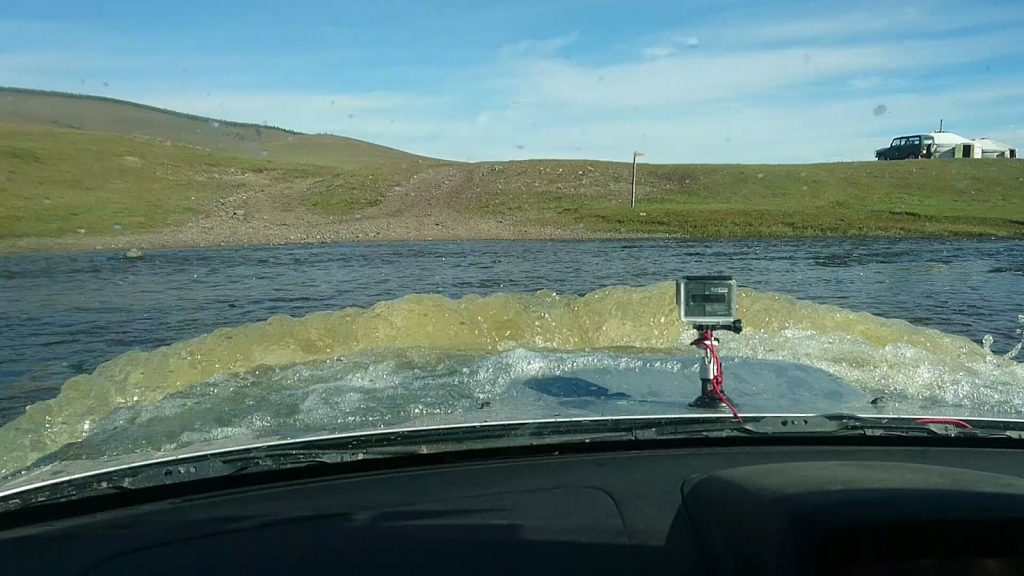
Crossing a stream in Naraas car
From there we drove further into the Orkhon Valley. This valley is of special historic and cultural importance to Mongolia, it has been a center for the nomadic culture for two millenia and is on the UNESCO World Heritage List. And it is simply a really, really beautiful place. The Orkhon river cuts through the mountains and formed a very broad valley, and it really looks exactly like you imagine Mongolia in your dreams. And it is really full of historic sites. For instance, one of our camp spots was just next to a hill top with very many stones on it. I didn’t really realize what it was, but later we where told that it is some kind of ancient tomb. Unfortunately, before we where told that, one member of our group had already taken a dump close to the rocks (it wasn’t me).
We visited the Orkhon waterfall, one of the major tourist sites (as the season was over, there were hardly any tourists though) in the area and a very pretty place.
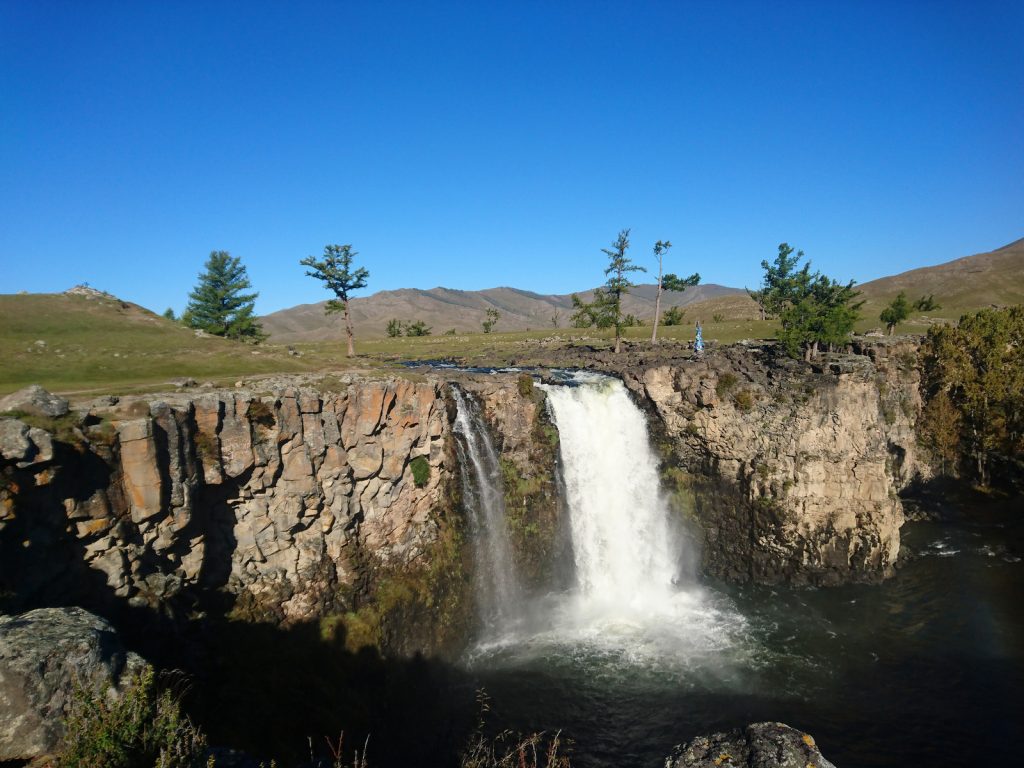
After the waterfall we decided to go to the Tsenkher Hot Springs. As the name suggests, this is a place with natural springs, where a couple of tourist camps have been built that have outdoor pools which are heated with the hot water from the springs. They also provide showers, which was something urgently needed after a few days of camping. Doing a camping tour has many advantages, it is really cheap and you can sleep in very beautiful places, but it also means that you have no facilities like showers or toilets for several days. Sometimes it is possible to use nomadic toilets, which are basically a hole in the ground with some kind of shelter around it. But often enough you just need to find a spot in the nature, and pay attention that you don’t sit down in an ant hill or desecrate ancient graves while doing your business.
Before we arrived at the hot springs, we spent a night at a small river. We stopped there more or less accidentally because the road to the planned camp site was blocked, but it turned out to be the most idyllic camping spot of the whole trip. Directly next to a river, with a lot of cows, yaks and horses around it.
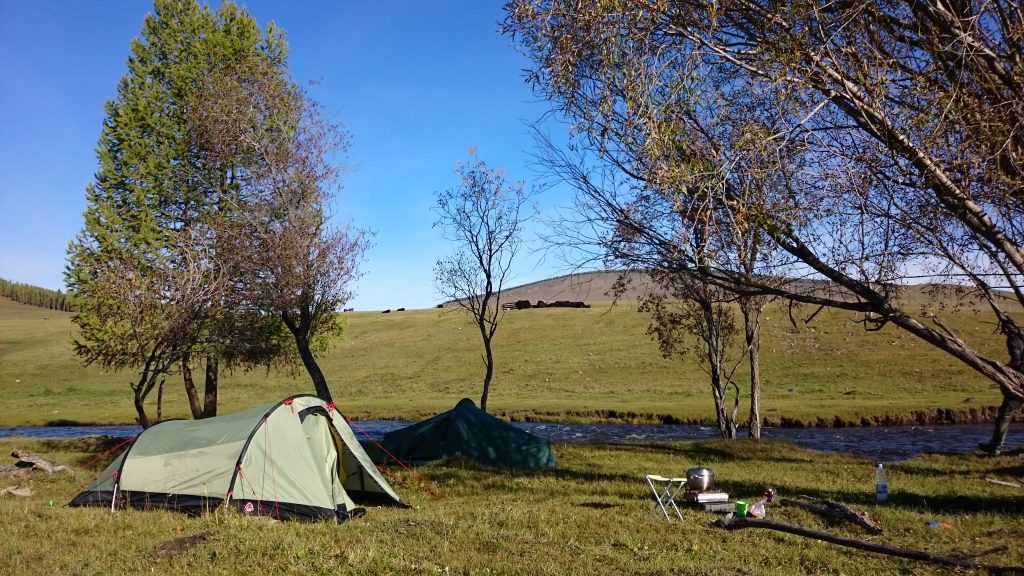
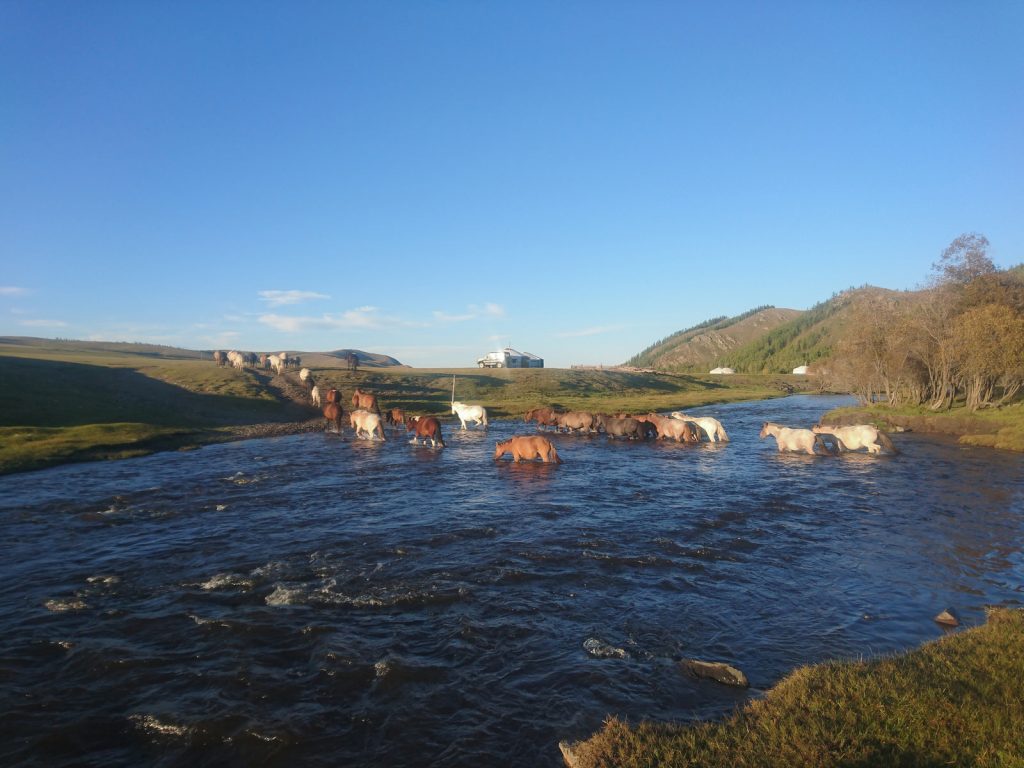
On this campsite, I had the most mongolian situation I could ever think of. We where sitting at the campfire at night playing cards and drinking airag (drink made of fermented horse milk with a bit of alcohol, the favourite beverage of Mongolians), when I heard that someone riding on a horse through the river towards our tents. A middle-aged mongolian man in the traditional nomad clothing then approached us, sat down from his horse and joined us on the fire. He and Naraa then talked a bit, where smoking a cigarette and drinking more airag. Afterwards Naraa told us that this guy was the head of the family living in the ger at the other side of the river, and he had just visited us to check out who we are because this was kind of his territory. The whole situation really felt surreal and like being in some kind of cowboy movie.
At the end of the trip, we had another truly authentic experience when Naraa took us to some of his relatives that still live as nomads somewhere deep in the countryside. We stayed there for two nights, spent some time with them and could see what the life of the nomads looks like in reality.

Our family for two days: I don’t remember their names correctly, but to my left was the father of the family we stayed with, next to Nina the mother and their daughter, and on the right their friends that live in the ger next to them
It was the first time that Naraa took visitors to his family, and although they had met foreigners before, it felt to them like they were visited by some kind of aliens (that’s what they actually said). None of them spoke english, so we couldn’t really talk to them a lot except when Naraa translated. Nevertheless it was a really nice time and the people there were really, really kind and funny. The atmosphere was really friendly and they made a lot of jokes (probably mostly about us).
We had been sleeping in gers before sometimes, but this time we really slept in the family ger of Naraas family while before it had always been tourist gers that just contained a few beds and nothing else. For nomad families, the ger is their home and they have everything inside that they need. A ger is a round tent with up to 10 m diameter that has white felt on the outside, giving it its typical look, and underneath that a layer of sheep fur. Inside, there is a wooden structure that keeps the ger in its shape, and is very robust yet also light and flexible. The whole ger can be assembled and disassembled in less than one hour and weighs only 250 kilos (that is not that much when you take into account it’s basically a complete house). Gers are very good at insulation, they especially keep cool in the summer when temperatures go above 40°C, but at the same time very good at ventilation.
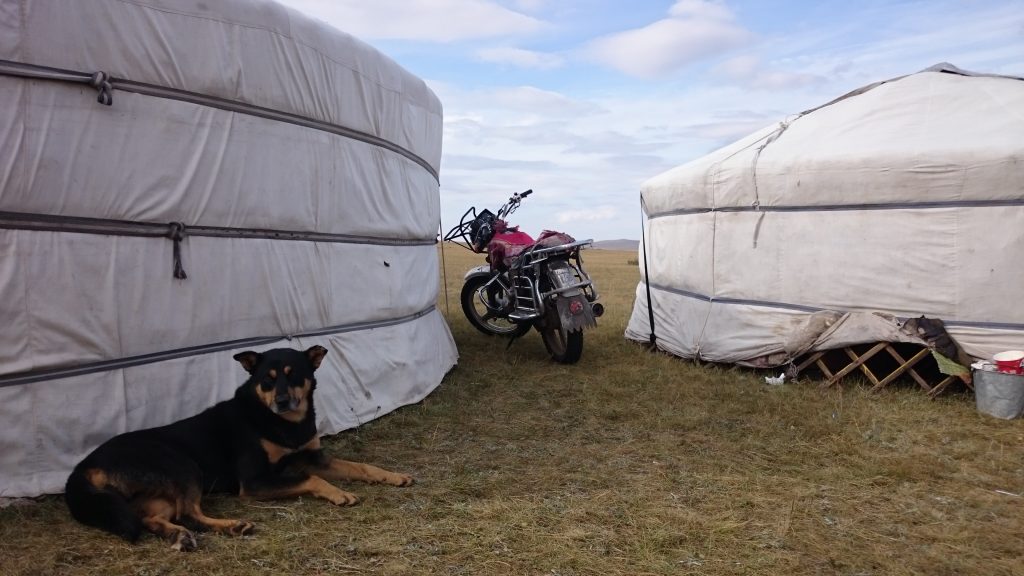
Ger from outside – you can see the wooden structure that keeps the gers shape
Inside, the layout is typically the same in any ger in Mongolia: The door faces the south, and when you enter, the left side is the male side, containing the bed of the families’ father, any hunting equipment and it is also the place where meat is stored. The right side is the female side, containing the bed of the mother and the kitchen area. In the center there is an oven and a small table, and in the back of the ger opposite the door is a table with important and representative stuff of the family and buddhist pictures.
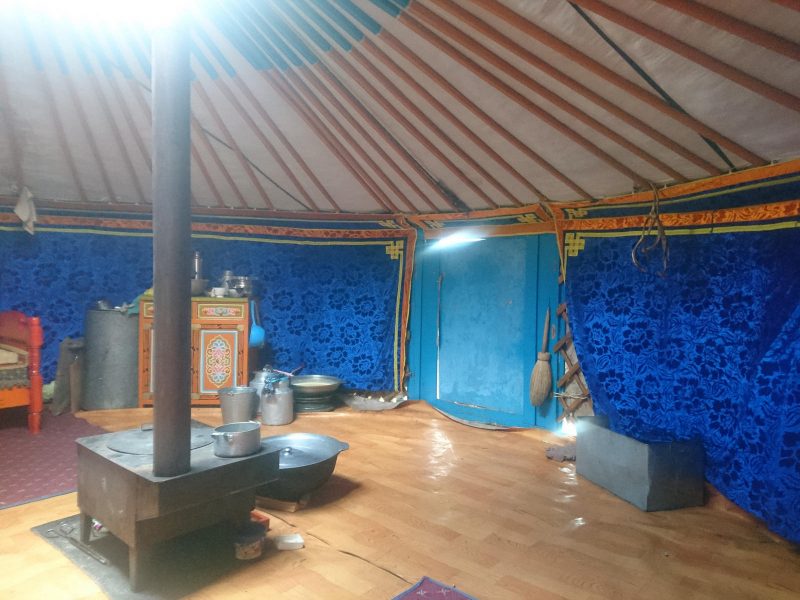
Front area with oven and kitchen board
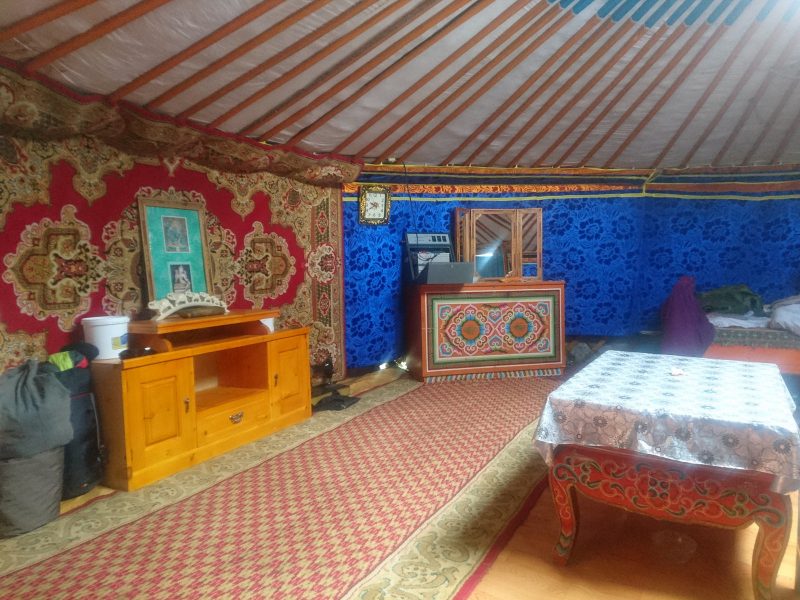
Back area with table and boards
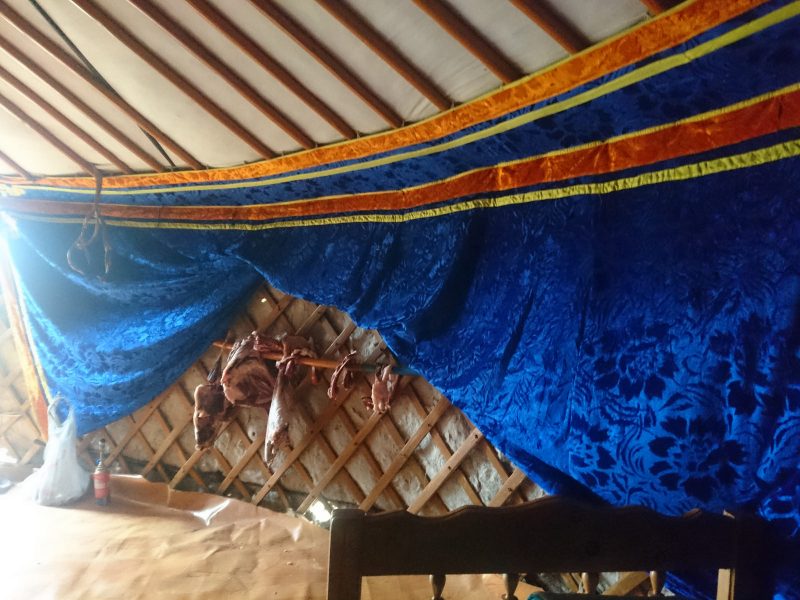
Meat hanging on the male side
The nomads lead a very simple life, but that doesn’t mean that their life is in in any way primitive. They have electricity through car batteries and nowadays also solar panels, and in their gers they have electric light, TV and cell phones. Nevertheless, there resources are definitely limited and they know how to make the best out of these limitations and live as sustainable as possible.
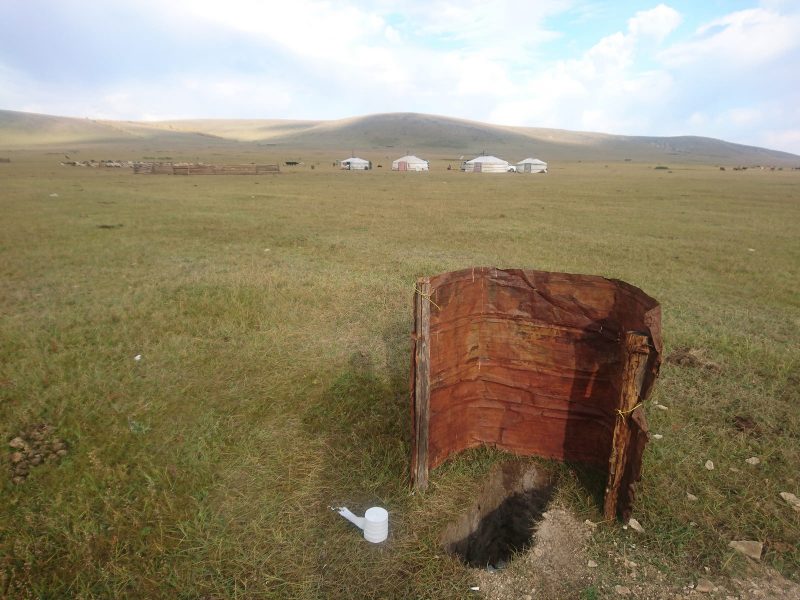
Toilet
When people hear “nomads”, they tend to think that these people move around all the time and cover large distances. But this is typically not the case, nomads do move around, but they normally only move 4 times a year, and each time they just move a couple of kilometers, so you will never find someone from the Gobi moving close to Ulaanbaatar or someone from the west moving deep into the Gobi desert. They are pastoralists, and their whole life revolves around their animals. In the beginning of spring, summer and fall, they bring the animals to new pastures where they can graze and move their ger to that place as well. In the winter, they move to a specific winter place where they live closer to other nomads and the animals have proper shelter structures.
We could watch the family doing their everyday business and even help a little bit. They have to milk the horses every two hours, and we helped one time by holding the foal – this is necessary because the mother will only give milk when she feels that the foal is drinking, so you have to trick her into giving milk by letting the foal drink for a couple of seconds, than pulling it away and start milking the mother, but leaving the foal standing next to her so she believes it is still drinking.

This is me helping to milk the horse – cannot really see it, but I am holding the foal so the mother thinks it is drinking
The horse milk is exclusively used to produce airag. The fresh milk is mixed with some old airag, and then it has to be beaten with some broom-like stick for two hours to start the fermentation process of the fresh milk. It then needs to sit for 12 hours until it is finished and you can drink it.
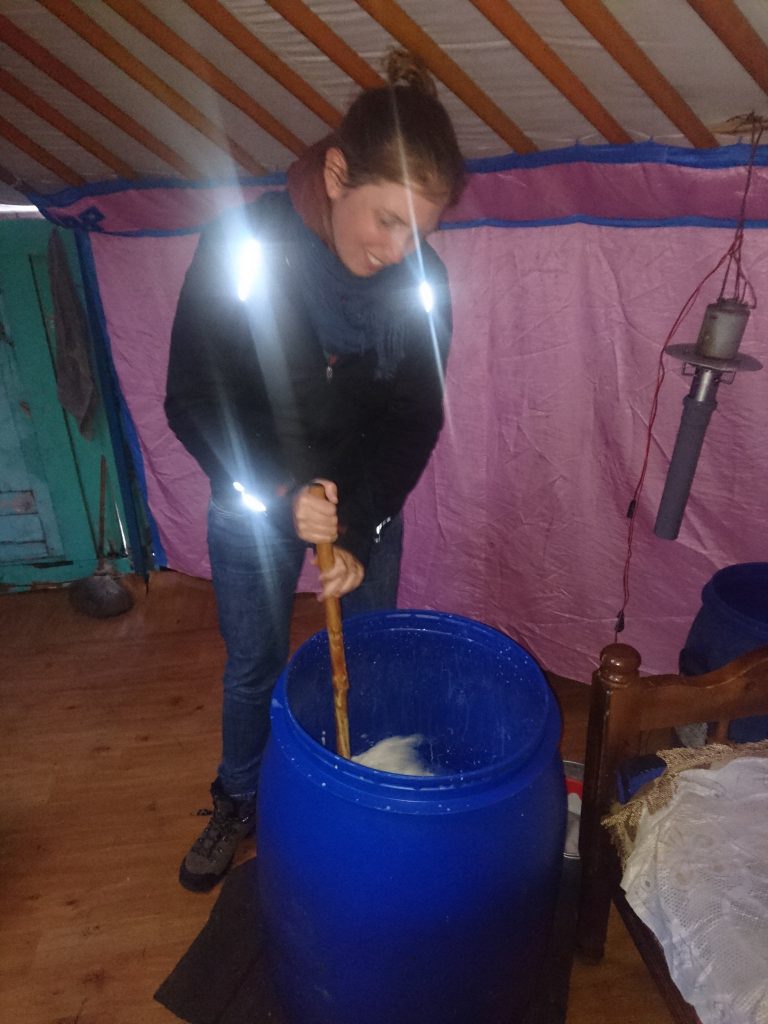
Nina producing airag

The families’ kids – I think their home with all the animals is just like a big playground to them
The most important part of staying with the family was the food. They prepared a lot of food for us, and in their culture, as in many other cultures, this is something that shows respect for the guest, and vice versa the guest has to show the respect for their culture by eating all of it.
Now, in a previous post I have already told my impression about mongolian food – specifically that it is not exactly one of my favourites. And with our hosts, we really got the full range of the mongolian cuisine. Except from a bit of grain products like noodles, they really eat nothing but meat (sheep and horse meat), milk products (yoghurt, dried yoghurt, milk tea, …) and meat with milk products (the first dinner was mutton dumplings boiled in milk).
It was a nice gesture by the people and we were honoured by it for sure, but it was really, really tough. Nina, after being a vegetarian for almost 5 years, got reintroduced to eating meat with a horse meat dumpling, and had to eat quite a lot of mutton through the next 2 days. For me it was a little bit easier, but still difficult. The nomads eat everything of the animal, which is definitely a good thing, if you live that lifestyle, you simply cannot afford to throw anything away. However that means that you eat the fat, the gristle, everything. And they are seriously insulted if you don’t finish you plate. And they made us drink lots and lots of tasty, but very fatty airag.
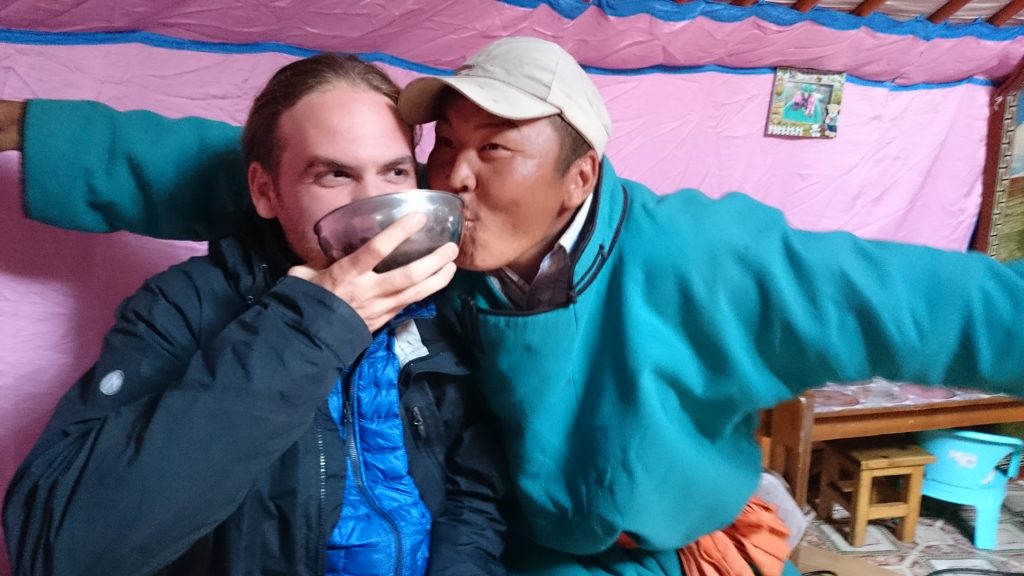
Drinking airag…
When we left the nomad family, the plan was to end the tour and get dropped off in a national park close to Ulaanbaatar where we wanted to go hiking for a couple of more days. That plan failed however, since in the night after we had left the family, the unusual food took its toll and knocked both of us out completely. Instead of hiking, we spent 3 days in a ger with diarrhea and sickness. I don’t know exactly what caused it – the food wasn’t bad for sure, I guess it was either bacteria that were uncommon to our stomaches, or simply the total excess of fat and milk that our digestion couldn’t handle.
Oh wow….well done.